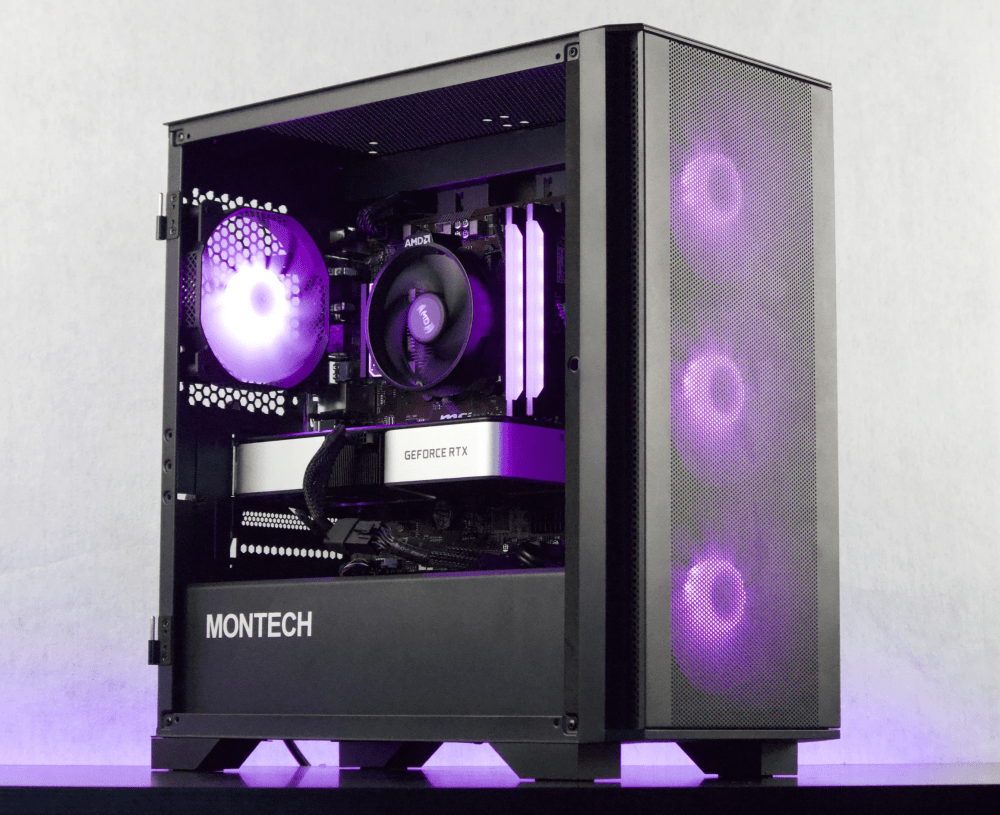Welcome to our blog post on how to clear GPU memory! If you're someone who uses graphic-intensive programs or games on your computer, you may have experienced the frustration of slow speeds, crashes, or errors. These issues can often be attributed to an overloaded GPU memory. But what exactly is GPU memory, and why does it need to be cleared?
In this blog post, we will delve into the basics of GPU memory and explain why it is important to clear it regularly. We will also discuss the signs of an overloaded GPU memory and how to check your GPU memory usage. Additionally, we'll explore various methods to clear your GPU memory and provide preventive measures to avoid overloading it in the first place and upgrading your GPU to fix it.
GPU memory, also known as video memory or VRAM (Video Random Access Memory), is a dedicated memory space on your graphics card. It stores data related to graphics processing, including textures, shaders, and other visual elements. When this memory becomes overloaded, it can lead to performance issues and hinder the smooth operation of graphic-intensive applications.
Before we jump into the methods of clearing GPU memory, let's first identify the signs that indicate your GPU memory may be overloaded. These signs include decreased performance and slow speeds, frequent crashes or errors, and an inability to run graphic-intensive programs or games smoothly.
To effectively clear GPU memory, it's essential to monitor its usage. In this section, we will guide you through different methods to check your GPU memory usage on various operating systems, including Windows, Mac, and Linux.
Now that you understand the importance of clearing GPU memory and how to monitor its usage, let's explore effective methods to clear your GPU memory. We'll discuss restarting your computer, closing unnecessary programs and applications, adjusting graphic settings, and even upgrading your GPU or adding more RAM.
Finally, we'll share some preventive measures to help you avoid overloading your GPU memory in the first place. These measures include regular monitoring of GPU usage, balanced use of graphic-intensive programs, keeping your system and drivers updated, and investing in hardware with higher GPU memory capacity.
By following the tips and techniques discussed in this blog post, you'll be able to clear your GPU memory effectively, enhance your computer's performance, and enjoy a smoother experience while using graphic-intensive applications or playing games. So, let's dive in and learn how to clear GPU memory!
Understanding the Basics: What is GPU Memory and Why it Needs to Be Cleared
GPU memory, also known as video memory or VRAM (Video Random Access Memory), is a dedicated memory space on your graphics card. While your computer's main memory (RAM) is responsible for general system operations, GPU memory is specifically designed to handle graphics-related tasks.
When you run graphic-intensive programs or games, the GPU processes and renders images, textures, shaders, and other visual elements. These data are temporarily stored in the GPU memory to facilitate quick access and efficient rendering. Think of GPU memory as a high-speed storage area exclusively for graphics processing.
So, why does GPU memory need to be cleared? Over time, as you use different graphic-intensive applications or games, the GPU memory can become filled with unnecessary data. This can lead to an overloaded GPU memory, resulting in performance issues and slower speeds.
When the GPU memory is overloaded, the graphics card has to constantly shuffle through a large amount of data, causing delays and bottlenecks in the rendering process. This can result in reduced frame rates, stuttering, or even crashes. Clearing the GPU memory helps free up space and allows the graphics card to perform optimally.
In addition to improving performance, clearing GPU memory can also resolve issues like artifacts or graphical glitches that may occur due to corrupted or fragmented data stored in the memory. By clearing the GPU memory regularly, you can ensure smooth and efficient operation of graphic-intensive applications or games.
Now that you understand the basics of GPU memory and why it needs to be cleared, let's move on to the next section, where we will identify the signs of an overloaded GPU memory.
Identifying the Signs of Overloaded GPU Memory
When your GPU memory becomes overloaded, it can result in noticeable performance issues and hinder the smooth operation of graphic-intensive programs or games. In this section, we will discuss the signs that indicate your GPU memory may be overloaded. By being aware of these signs, you can take the necessary steps to clear your GPU memory and improve your system's performance.
Decreased Performance and Slow Speeds
One of the primary signs of an overloaded GPU memory is a decrease in overall system performance. You may notice slower speeds and delays when performing tasks that require graphics processing. This can include rendering images, videos, or 3D models, as well as running graphic-intensive applications or games. If you experience a significant drop in performance, it may be an indication that your GPU memory is overloaded and needs to be cleared.
Frequent Crashes or Errors
Another common sign of an overloaded GPU memory is the occurrence of frequent crashes or errors. When the GPU memory is overwhelmed with data, it can lead to instability in the system, causing crashes or freezing. You may encounter error messages related to graphics card issues or experience sudden program terminations. If you consistently encounter crashes or errors while using graphic-intensive programs, it's likely that your GPU memory is overloaded and needs attention.
Inability to Run Graphic-Intensive Programs or Games
If your GPU memory is overloaded, you may find that you are unable to run graphic-intensive programs or games smoothly. These applications rely heavily on the GPU memory to render complex graphics and textures. If your GPU memory is unable to handle the load, you may experience lag, stuttering, or even an inability to launch these programs altogether. If you find yourself struggling to run graphic-intensive applications, it's a clear indication that your GPU memory needs to be cleared.
By being vigilant for these signs, you can identify when your GPU memory is overloaded and take appropriate action to clear it. In the next section, we will explore different methods to check your GPU memory usage, which will help you determine if your GPU memory is indeed overloaded.
How to Check Your GPU Memory Usage
To effectively clear your GPU memory, it's essential to monitor its usage. By checking your GPU memory usage, you can determine if it is approaching its limits or if it is already overloaded. In this section, we will guide you through different methods to check your GPU memory usage on various operating systems, including Windows, Mac, and Linux.
Using Task Manager in Windows
On Windows operating systems, you can use the built-in Task Manager tool to monitor your GPU memory usage. Follow these steps:
- Right-click on the taskbar and select "Task Manager" from the context menu.
- In the Task Manager window, click on the "Performance" tab.
- In the left-hand sidebar, select "GPU" to view GPU-related performance metrics.
- Look for the "Dedicated GPU Memory" or "GPU Memory" section to see the current usage of your GPU memory.
Using Activity Monitor on Mac
If you are using a Mac, you can utilize the Activity Monitor application to check your GPU memory usage. Here's how:
- Open the "Applications" folder and go to the "Utilities" folder.
- Launch the "Activity Monitor" application.
- In the Activity Monitor window, click on the "System Memory" tab.
- Look for the "VRAM (Dynamic, Max)" section to view the current usage of your GPU memory.
Using System Monitor in Linux
Linux users can rely on the System Monitor utility to check their GPU memory usage. Here's what you need to do:
- Open the System Monitor application. The exact method may vary depending on your Linux distribution, but it is usually accessible from the Applications menu or the system tray.
- In the System Monitor window, click on the "Resources" or "Performance" tab.
- Look for a section related to GPU or graphics. The specific label may vary depending on your system and desktop environment.
- Check the GPU memory usage to see how much of your GPU memory is currently being utilized.
By using these methods to check your GPU memory usage, you can get a better understanding of how much memory is being used and determine if it is approaching its limits. This information will help you make informed decisions on when and how to clear your GPU memory effectively.
In the next section, we will explore different methods to clear your GPU memory, allowing for improved performance and smoother operation of graphic-intensive applications.
Methods to Clear Your GPU Memory
Once you've determined that your GPU memory is overloaded, it's important to clear it to improve performance and ensure smooth operation of graphic-intensive programs or games. In this section, we will discuss various methods to clear your GPU memory effectively.
Restarting Your Computer
One simple and effective method to clear GPU memory is to restart your computer. When you restart your system, all processes, including those utilizing GPU memory, are terminated, and the memory is cleared. This can help resolve any temporary data buildup or fragmentation in the GPU memory. After restarting, you should experience improved performance and smoother operation.
Closing Unnecessary Programs and Applications
Another way to clear GPU memory is by closing unnecessary programs and applications that are currently running. These programs may be utilizing GPU memory, even if you're not actively using them. By closing them, you free up valuable GPU memory for the applications or games you want to prioritize. Make sure to check your system tray or taskbar for any background processes that may be using GPU resources and close them if not required.
Adjusting Graphic Settings
Adjusting your graphic settings can also help clear GPU memory. By reducing the level of graphical detail or decreasing the resolution in your games or applications, you can lower the demand on the GPU memory. This can free up memory for other processes and help alleviate the overload. Consider reducing the texture quality, anti-aliasing, or shadows to reduce the GPU memory usage.
Upgrading Your GPU or Adding More RAM
If you consistently experience GPU memory overload, even after trying the previous methods, it may be worth considering upgrading your graphics card or adding more RAM to your system. A more powerful GPU with higher memory capacity can handle graphic-intensive tasks more efficiently, reducing the chances of overload. Additionally, for systems using intigrated graphics adding more RAM can provide extra memory resources for the iGPU to work with.
It's important to note that upgrading hardware requires careful consideration and compatibility with your existing system. Consult with a knowledgeable professional or refer to manufacturer guidelines before making any hardware upgrades.
By utilizing these methods to clear your GPU memory, you can optimize its performance and ensure smoother operation of graphic-intensive programs or games. In the next section, we will discuss preventive measures to avoid overloading your GPU memory in the first place.
Preventive Measures to Avoid Overloading GPU Memory
To avoid overloading your GPU memory and ensure optimal performance, it's important to implement preventive measures. By following these measures, you can maintain a healthy GPU memory usage and prevent issues related to overload. In this final section, we will discuss some preventive measures to help you avoid overloading your GPU memory.
Regular Monitoring of GPU Usage
One of the key preventive measures is to regularly monitor your GPU usage. Use the methods discussed earlier to check the GPU memory usage and keep an eye on its levels. By monitoring the GPU usage, you can identify any significant spikes or prolonged high usage that may indicate an impending overload. Regular monitoring allows you to take proactive steps to clear the GPU memory before it becomes overwhelmed.
Balanced Use of Graphic-Intensive Programs
To prevent GPU memory overload, it's important to use graphic-intensive programs in a balanced manner. Avoid running multiple graphics-intensive applications simultaneously, as this can put a heavy load on your GPU memory. When possible, close unnecessary programs or background processes that may be using GPU resources. By ensuring a balanced use of graphic-intensive programs, you can prevent excessive strain on the GPU memory.
Keeping Your System and Drivers Updated
Keeping your system and GPU drivers up to date is crucial for optimal performance and stability. Graphics card manufacturers regularly release updates that include performance improvements and bug fixes. These updates may also optimize GPU memory usage. Check for updates from your graphics card manufacturer and install them to ensure you have the latest drivers. Additionally, keep your operating system updated to benefit from any performance enhancements or bug fixes related to GPU memory management.
Investing in Hardware with Higher GPU Memory
If you frequently work with graphic-intensive applications or play demanding games, consider investing in hardware with higher GPU memory capacity. A graphics card with more VRAM can handle larger and more complex data sets, reducing the chances of GPU memory overload. Assess your needs and choose a graphics card with sufficient memory capacity to accommodate your usage requirements.
By implementing these preventive measures, you can maintain a healthy GPU memory usage and avoid overloading it. Regular monitoring, balanced usage, keeping your system updated, and investing in hardware with higher GPU memory capacity will contribute to a smoother and more efficient experience while using graphic-intensive applications or games.
Conclusion
Clearing GPU memory is essential for optimizing performance and ensuring smooth operation. By understanding the basics of GPU memory, identifying the signs of overload, checking GPU memory usage, utilizing methods to clear GPU memory, and implementing preventive measures, you can effectively manage and maintain a healthy GPU memory usage.
By following these guidelines, you'll be able to clear your GPU memory effectively, enhance your computer's performance, and enjoy a seamless experience while using graphic-intensive applications or playing games. So, implement these practices, monitor your GPU memory regularly, and take necessary action to ensure optimal performance and longevity of your graphics card.
Looking to upgrade your GPU? Check out Jawa for killer deals on new and used graphics cards.





